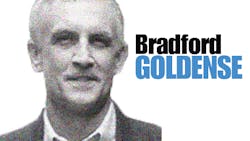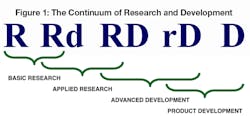What’s The Difference Between Research and Development?
Due to a combination of the changing corporate approaches described above, the desires of developers to bring solutions to markets and not just a piece of a solution, the globalization of R&D that has decentralized R&D, and naming conventions for product organizations that differ by country, one can no longer just pay attention to product-development pipelines to stay abreast of what might be coming to market. The jury is still out as to whether today's approaches will prove more productive than historical approaches that restricted the scope of projects to reduce uncertainty and improve forecastability of key enabling features and technologies — and then turned these enablers over to product development.
Research and development is a continuum, and highly analog rather than digital in construct. Historically, R&D could generally be segmented into four categories: Basic Research, Applied Research, Advanced Development, and Product Development. "Skunk Works" was perhaps a fifth category, a discussion for another day.
Applied Research typically has a more specific target. There is some known problem, opportunity, or application area where an economic gain or social improvements is possible. Applied Research picks up by taking things that might work and attempts to narrow down the feasible solutions.
Advanced Development takes the feasible solutions and culls out the best alternative(s) to achieve a target capability or feature to incorporate into products. As said earlier, some advanced and innovation organizations now actually bring the entire product to market.
Finally, Product Development packages feasible and risk-reduced features and capabilities in both form and function into products planned for release to the marketplace. The Venn diagrams of each of these four historical R&D categories always overlapped, but the overlaps have grown significantly in recent years.
In short, research and advanced development historically did not bring products with full form and function to market. They specialized in experimentation and analysis, combined with breadboards and brassboards to demonstrate feasibility. Form and function was the job of Product Development. Professionals in these preproduct-development organizations were largely senior scientists and engineers who specialized in discovery and narrowing-down feasibility issues. The knowledge of manufacturing capabilities and constraints, packaging, logistics, costing, and other "product launch" disciplines were nearly exclusively the realm of Product Development. Today, the lines of organization purpose and demarcation are not as clear.
About the Author
Bradford Goldense
Contributing Technical Expert
Bradford L. Goldense is founder and president of Goldense Group, Inc. [GGI] (www.goldensegroupinc.com), a consulting, market research, and education firm focused on business and technology management strategies and practices for product creation, development, and commercialization. He has been an adjunct faculty member of the graduate engineering school at Tufts University's Gordon Institute for 19 years. Goldense is a Certified New Product Development Professional [NPDP], a Certified Manufacturing Engineer [CMfgE], a Certified Computer Professional [CCP], and is Certified In Production & Inventory Management [CPIM]. He holds over 200 registered copyrights and is a recognized subject-matter expert, including appearances on PBS and CNBC. He has consulted to over 250 companies and over 750 manufacturing locations on four continents since founding GGI in 1986. Goldense holds an MBA in Accounting from the Cornell Johnson School and a BSCE from Brown University. For more information, please see Brad's LinkedIn profile or visit GGI's home page.


